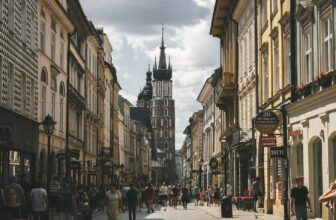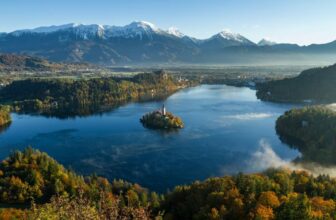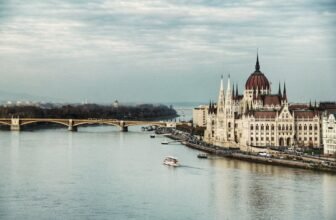There are many amazingly beautiful buildings in the world. Seven best of them called wonders of the world. It is truly amazing works of art that seem miraculous: the Pyramids of Egypt, Alexandria lighthouse Gardens of Babylon …
But beauty has many faces, it is embodied in various forms, and many of these incarnations are in
Kiev. The article tells about 7 wonders of the capital of Ukraine.
St Andrew’s сhurch
The Church of St Andrew sits on top of the hill, where St Andrew, one of the Apostles of Jesus Christ, erected a cross and prophesied a great future for a city that would rise on the nearby hills.
The leading architect of Italian descent Francesco Bartolomeo Rastrelli was commissioned by the Russian Imperial Court to design a new church dedicated to St Andrew to be built on the ancient site. The construction, which was supervised by the local architect Ivan Michurin, lasted from 1749 to 1754. St Andrew’s ingeniously combines several architectural styles, the predominant of which is late baroque.
The gilded carved-wood iconostasis, icons, murals and interior decor form one impressive whole which evokes musical associations.
By the middle of the twentieth century, it became evident that the church required considerable restoration which was carried out in the 1960s. After the restoration it was turned into a museum but occasional religious services are still held there, as well as concerts of classical music.
A great view on the left bank of the Dnipro River opens from the terrace around the church.
House with chimeras
Such is the name that was given by the people of Kyiv to the building that the famous architect Vladyslav Horodetsky built for himself in the early twentieth century.
The building is indeed decorated with sculptures made of cement, the building material which at that time only began to be widely used, which reflects the unbridled imagination of Horodetsky — sea and land monsters, fabulous beasts, mermaids and other bizarre creatures perch on the roof and crawl on the walls.
The building sits on the slope of a hill and that is why on one side it has three stories and on the other — six. It is an eclectic mixture of several architectural styles but the general impression it makes is that of a fairy-tale creation in the otherwise pedestrian architectural setting.
The “house with chimeras” is situated right opposite the pompous building of the presidential administration and is used for state receptions
Vidubitsky Monastery
One of the oldest monasteries in Ukraine is close to the National Botanic Garden .The west side has access to the embankment of the Dnieper river. Under the monastery complex are located Zverynets caves where early Christians lived long before Prince Volodymyr the Great baptized Rus. After the baptism , the monks left the caves and founded Vidubitsky monastery. Here in the monastery, the monks conducted the Kiev Chronicle, and created one of the versions of the “Tale of Bygone Years”.
St. Volodymyr’s Cathedral
It was in 1852 that the suggestion was made by the metropolitan Philaret of Moscow to design a unique Cathedral to memorialize the 900th anniversary of the baptisim of ‘Kievan Rus’. As a consequence, by 1859, just seven years after the suggestion was put forward, the Cathedral of St. Volodymyr came into existence. Construction of the cathedral was mainly through the contributions of people who belonged to the Russian Empire, amassing a fund of over 100, 000 rubles by the start of construction.
Much of the Byzantine style can be seen in the colorful interior of the St. Volodymyr’s Cathedral, from mosaics created by professionals from Venice to Frescoes created by famous painters such as V.Kotarbinsky, S. Kostenko, M.Pymonenko, and M. Nesterov, P. Swedomsky, M. Vrubel, V. Zamyraylo and V. Vasnetsov, under the direction of Professor A. Prakhov. V. Vasnetsov became the primary painter of the “Holy Mother of God”, which later became the center piece for the alter apse and is regarded greatly as a masterpiece of fine art around the world.
Kyiv- Mohyla Academy and the Old Hem
Hem is one of the most interesting areas of the ancient city. According to historians, in the first half of I millennium BC there already was a settlement that was a trading center. The most picturesque path goes through Andrew Descent to Hem. This road leads to Kontraktowa area and the main body of the Kyiv-Mohyla Academy. ” Mohyla ” was founded in 1620 on the basis of the Kyiv Brotherhood School which has been a long time the only institution of higher education not only in Ukraine but throughout the Eastern Europe.
Hem is one of the most interesting places for walking. From here you can reach the Dnieper embankment and then go to the Park Bridge which leads to Trukhaniv Island. Futher you can get to Vozdvizhenka – an elite and very beautiful area which is called “little Lviv” in the middle of Kiev.
Pechersk Lavra Monastery
The monastery dates from the eleventh century. It is believed to have been founded by the monks Antoniy and Feodosiy.
Soon after its foundation, the monastery became a major cultural center in addition to being a leading religious community in the land. Thanks to the monks’ pious efforts, Christianity was consolidated in the lands of Kyivan Rus.
The word “Lavra” (from the Greek word “laura” — “lane”) is an evidence of the monastery’s highest status among the Orthodox monasteries of Ukraine.
Throughout the ages, culture was upheld in the monastery, chronicles were written, icons and murals were painted, books were published, and new buildings were built.
At present, part of the monastery is a national cultural and historical reserve with several museums — Museum of Books; Museum of Applied and Decorative Arts; Museum of Treasures, to name but a few — functioning on its territory. The museums are housed in the buildings that date to the seventeenth, eighteenth and nineteenth centuries.
The Lavra reserve is a major tourist attraction in Kyiv and the monastery attracts an untold number of faithful pilgrims.
Holy Sophia
The cathedral was built in the first half of the eleventh century (chronicles mention two dates for the beginning of the construction of the church dedicated to Holy Sophia, or God’s Wisdom — 1017 and 1037). The initiator of the construction was the then ruler of Kyiv, Grand Duke Yaroslav the Wise.
The cathedral acquired a status of the “chief church” of Kyivan Rus. The cathedral was a place where coronations were held, audiences were given, foreign delegations were received and matters of state and faith were discussed and decided. Yaroslav had a library and a school established at the cathedral, thus expanding its role of a cultural centre. Chronicles were written, books were translated and the Duke’s cultural drive earned him a byname of “Wise” (incidentally, Yaroslav was buried in the cathedral in a marble sarcophagus).
The cathedral is famous for its magnificent mosaics and frescoes many of which have been preserved in their original glory despite many wars, insurrections and invasions that raged over the city of Kyiv in the ten centuries that passed since the foundation of the cathedral.
The restoration work revealed many original frescoes that were covered by layers of paint that accumulated in later centuries during the attempts to “renew” them.
At present, the Holy Sophia Cathedral is a museum; religious services are held there only on some special occasions.




